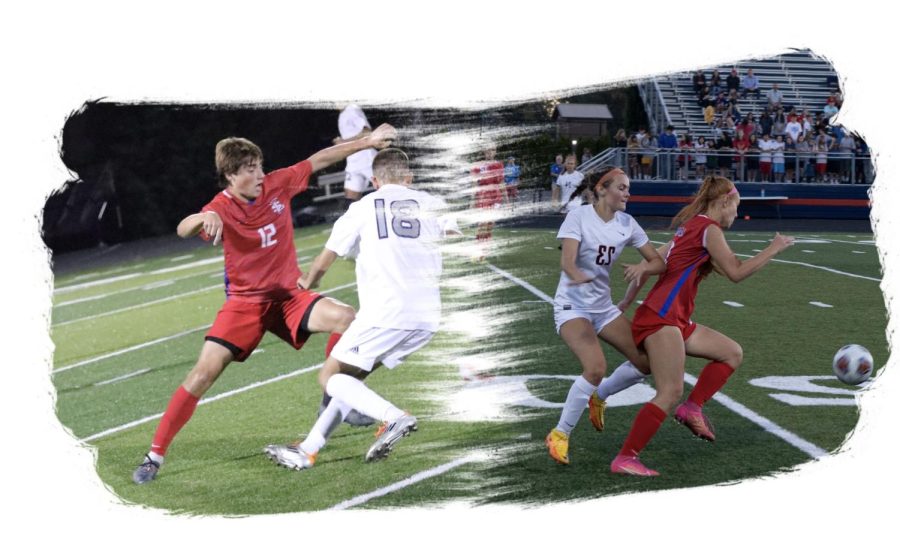Same Name Different Game — The Sexist Differences Between Girls and Boys Soccer
“Do not referee a girls game the same way you would a boys game. Girls are much less likely to want to play through some contact with opponents that boys typically want to shrug off,” said Patrick Duffy, OSAA’s soccer rules interpreter in a sexist bulletin that was sent out to coaches, athletic directors and soccer referees in Oregon.
November 16, 2022
Despite the induction of Title IX — a federal law that prohibits discrimination on the basis of sex — into common law and culture, disparities between boys and girls sports still run rampant, especially at the high school level.
I have been both a participant and supporter of women’s sports my whole life. Soccer has been a huge part of my childhood, and has shaped me into the person I am today.
Therefore, issues that surround women’s sports, especially regarding equality, hit close to home for me.
On Sept. 20 Patrick Duffy, the soccer state rules interpreter at Oregon Schools Activities Association (OSAA), released a blatantly sexist bulletin — which was distributed to coaches, athletic directors, and soccer referees in Oregon — in which he addressed the uptick in red cards in girls soccer games this year, as well as providing what he believes could be possible ‘solutions.’
That same day, the bulletin was taken down from the OSAA website due to a backlash from readers.
Nevertheless, nothing disappears on the internet. Elite Oregon Girls, a media outlet for girls’ high school sports, was able to capture some of the standout sexist quotes that were not only included but emphasized in the OSAA bulletin:
- “Do not referee a girls’ game the same way you would a boys’ game. Girls are much less likely to want to play through some contact with opponents that boys’ typically want to shrug off.”
- “If you hear a player shouting at an opponent, hit the whistle immediately and loudly! If you do not stop play immediately for this, there is a very high probability that a fight is about to start.”
- “At least one and probably two cards need to come out quickly, so the players can go to the bench and calm down.”
- “In my experience, high school girls do not shout like that without provocation, either.”
Since the original posting, Patrick Duffy and OSAA have apologized for the bulletin.
As part of the repercussions Duffy is receiving for his actions, he gets to keep his job so long as he undergoes the National Federation of State High School Associations’ implicit bias training in addition to OSAA’s equity training.
Is that enough?
No matter the gender, race, or sexuality of a player, the fundamental aspects of soccer don’t change.
Physicality and contact are well within the realms of the sport as a whole, and they increase through higher levels of the game. A well-paced game will naturally have a competitive energy, and in a contact sport, that comes with increased physicality.
Mr. Duffy’s explicit and public emphasis on how, “Girls are much less likely to want to play through some contact with opponents that boys typically want to shrug off,” essentially sends the message that girls are mentally and physically weaker than our male counterparts, which is disheartening to hear as a female player myself.
An OregonLive article, published on Sep. 27, captures the perspective of multiple high school girls soccer coaches in their reaction to the OSAA bulletin. In the article, Manoli Tjuanakis, head coach for Grant High School girls soccer program is quoted saying:
“I mean, in general, the girls are treated differently,” he said. “They are not allowed to play the same physical game as the boys and you will see a fall or a stoppage of the game to take place if a girl goes down on the field that you are not going to get the same reaction if there’s a boy going down on a tackle.”
There is no frustration like competing in a hard-fought game and having the referee call each and every minuscule amount of physical contact as a foul. Or when you try to speak up for yourself, as a person and player, to ask the ref for the reasoning behind the foul called, but being met with getting told to be quiet and to not ask questions.
For me, the majority of this frustration is because I think to myself, ‘would this same ref have called that foul in a boys game’? In my experience, a small push in a girls game is seen as a shove, and a small push in a boys game is seen as part of the competitive nature of the game.
Boys and girls play with the same exact set of rules, duration, and field size for a game, and yet — aside from the biological differences — the only varying factor is the calls of the referees.
The only attestable difference between boys and girls soccer is the literal biology of the two sexes, however, that is not to negate the topic of the inclusion of transgender athletes in sports. Typically, boys are biologically built faster and stronger than girls, but that should not change the standards of the game.
Saying that “girls are much less likely to want to play through some contact with opponents that boys typically want to shrug off,” is completely disrespectful and undermining to female athletes everywhere. This statement operates under the assumption and generalization that girls are weak, that we can’t handle contact, and that we will get upset — not being able to ‘shrug it off’ as a boy would be able to.
I believe that this speaks to something beyond the realm of high school sports, perpetuating gender stereotypes that not only prohibit the growth and flow of girls soccer but also send a negative message to female athletes that it is okay to be treated differently because of their gender.
I’m not going to argue the fact that there is a difference between boys and girls soccer because the biology of each sex leads to physical differences in the game like overall speed and tempo. However, that should not be used as a testament to judge the threshold of physicality that female players can or cannot endure.
Physicality is a key aspect of soccer, and it fosters a healthy competitive environment in that athletes can gain a lot from, even beyond being on the field. Learning how to push yourself and how to be resilient in the face of a challenge are just a few of the lessons that contact sports can teach athletes; thus, this is another reason that there should be equal, and fair, refereeing between girls and boys sports. Calling weaker contact as fouls in a girls game that wouldn’t be called in a boys game prohibits a portion of this growth because of the difference in standards between genders.
Soccer is a physical sport, and it is up to the referees of a match to call the rules of the game as they see fit. While each referee has their own view of the game, each and everyone is supposed to judge plays in relation to the rule book. With the publishing of sexist parameters of refereeing, the integrity of the refs and the possibility of growth for female players is compromised.






Aaron Hollingshead • Nov 18, 2022 at 5:34 pm
Clare – love your article! Kudos.
Cha Lakshmi Asokan • Nov 17, 2022 at 7:38 am
Excellent Clare. I am so proud of you for standing up to bias and inequity. Well done, let’s change this culture.